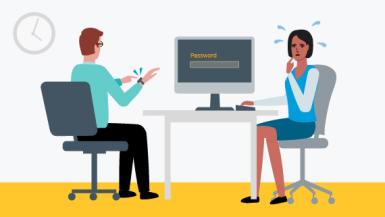SSO: How single sign-on can save time and strengthen your firm's security
Key Points
- SSO (single sign-on) enables users to securely access multiple systems with a single set of log-in credentials.
- Financial advisors can use SSO to help streamline workflows—and work more securely.
- For SSO to work, your software must be compatible. Check with your platform providers to confirm which features they support.
Chances are your firm juggles multiple software tools each day, each with its own login. That means wasted time, password fatigue and unnecessary friction in your day.
Single sign-on (SSO) simplifies access to all your essential tools—email, CRM, research tools, portfolio software, and more—so you can work faster and more securely. With just one login, you can move easily between systems, get information faster, elevate client service and keep your firm and client data safe.
How does it work? Let's explore.
What is single sign-on?
SSO is an authorization technology that lets users log into multiple applications and websites with a single set of credentials. While there many different technical approaches to SSO, the core idea is to verify your identity through an authentication token that's unique to you. Then, when you want to log into a site, that token confirms that it's really you. For advisors, this means that once you log into one system that's integrated with SSO, you can do a lot without punching in another set of login credentials.
Key benefits of SSO
SSO can be a workflow gamechanger. Here's how:
- Boosts productivity
Logging into multiple systems throughout the day adds up, especially if you frequently move between systems or struggle to remember passwords. (And who hasn't fumbled trying to remember a password during a call or while sharing a screen?). By reducing the number of login events each day, you have more time and mental energy to focus on serving your clients - Improves password security
Some people are notoriously bad at juggling usernames and passwords. They write them on sticky notes tacked to their monitor or reuse the same password over and over. It's understandable, given the average person manages over 250 passwords between personal and work accounts. Using SSO reduces the number of passwords you need to remember, helping break these bad habits.1 Plus, SSO fits naturally with cloud-based app environments and zero-trust security models, both of which many companies now rely on. (A zero-trust security model follows a 'never trust, always verify' mindset to keep internal data safe.) - Adds another layer of protection
SSO is most effective when combined with multifactor authentication (MFA), which many providers now offer. SSO and MFA are key building blocks of a zero trust security approach. MFA requires users to use another "factor" to complete the login. Many systems send text messages with a temporary code to the user's mobile device. The user then enters the code, which functions as a second password. Some systems require an authenticator app to supply a temporary code. And, while less common, others prompt users for a physical token, usually a device that plugs into a computer drive and that works like a key, unlocking the computer or software. - Helps you monitor your network
Because security is such an important part of SSO, many authentication systems include identity and access management, which can offer login monitoring, role-based access control, and risk-based rules that flag uncommon or suspicious logins.
Integration for the win
Single sign-on is a tech integration that can make life easier for you and improve your ability to serve clients. And combining SSO with other integrations makes it simpler to complete tasks efficiently, especially key account management tasks that can take up a lot of time. Teams with SSO typically love the convenience; and IT professionals and firm owners appreciate knowing there's another layer of security protecting the firm's data. Check with your software platform providers to explore what's possible and take your workflows to the next level.
What you can do next
- Learn more about single sign-on (SSO) and the range of integrations available with Schwab Advisor Center.
- Help protect your firm and your clients from digital threats. Explore cybersecurity and fraud prevention best practices.
- If you don't yet work with Schwab, consider a custodian that is invested in your success. Contact us to learn more about the potential benefits of a custodial relationship with Schwab.
1. NordPass, "Juggling security: How many passwords does the average person have in 2024?" April 2024.
